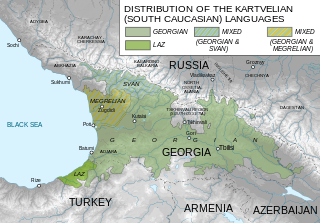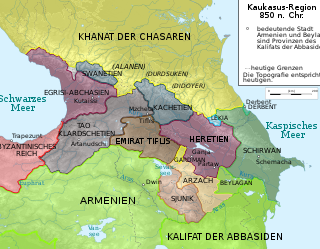| Aghsartan II აღსართან II | |
|---|---|
| King of Kakheti and Hereti | |
| Reign | 1102 – 1105 |
| Predecessor | Kvirike IV |
| Dynasty | Kvirikian |
| Religion | Islam |
Aghsartan II (Georgian :აღსართან II), was the last King of medieval Kakheti and Hereti in eastern Georgia from 1102 to 1105.

Georgian is a Kartvelian language spoken by Georgians. It is the official language of Georgia. Georgian is written in its own writing system, the Georgian script. Georgian is the literary language for all regional subgroups of Georgians, including those who speak other Kartvelian languages: Svans, Mingrelians and the Laz.

The Kingdom of Kakheti-Hereti or just the First Kingdom of Kakheti was a early Medieval monarchy in eastern Georgia, centered at the province of Kakheti, with its capital first at Telavi. It emerged in c. 1014 AD, under the leadership of energetic ruler of principality of Kakheti, Kvirike III the Great that finally defeated the ruler of Hereti and crowned himself as a king of unified realms of Kakheti and Hereti. From this time on, until 1104, kingdom was an independent and separated state from the united Kingdom of Georgia. The kingdom included territories from riv. Ksani to Alijanchay river and from Didoeti to southwards along the river of Mtkvari.

Georgia is a country in the Caucasus region of Eurasia. Located at the crossroads of Western Asia and Eastern Europe, it is bounded to the west by the Black Sea, to the north by Russia, to the south by Turkey and Armenia, and to the southeast by Azerbaijan. The capital and largest city is Tbilisi. Georgia covers a territory of 69,700 square kilometres (26,911 sq mi), and its 2017 population is about 3.718 million. Georgia is a unitary semi-presidential republic, with the government elected through a representative democracy.
He succeeded upon the death of his father Kvirike IV. The medieval Georgian chroniclers characterize him as a frivolous man whose ignorant rule drew many great nobles into opposition. In 1105, Aghsartan was arrested by his vassals, the princes Arishiani of Hereti, [1] and handed over to King David IV of Georgia who finally annexed the kingdom of Kakheti to the unified all-Georgian realm.
Kvirike IV was a King of Kakheti and Hereti in eastern Georgia from 1084 to 1102.
Arishiani was a 12th-century Georgian noble (didebuli) of Hereti. Arishian alongside with other nobles, such as Baram and Kavtar, captured King Aghsartan II of Kakheti and delivered him to the King David IV of Georgia, the latter reincorporated kingdom of Kakheti and Hereti within his realm. For this he was granted duchy of Hereti.

David IV, also known as David the Builder, of the Bagrationi dynasty, was a king of Georgia from 1089 until his death in 1125.





